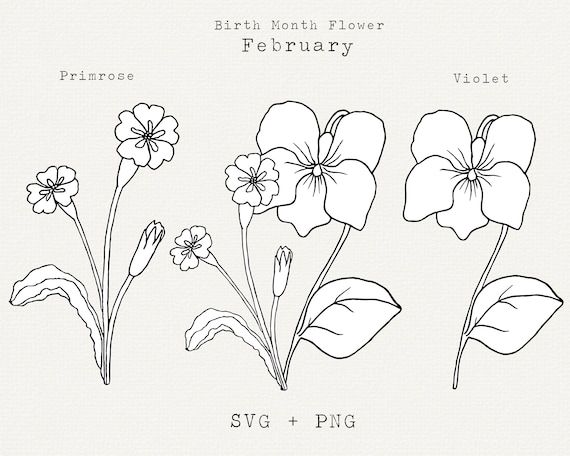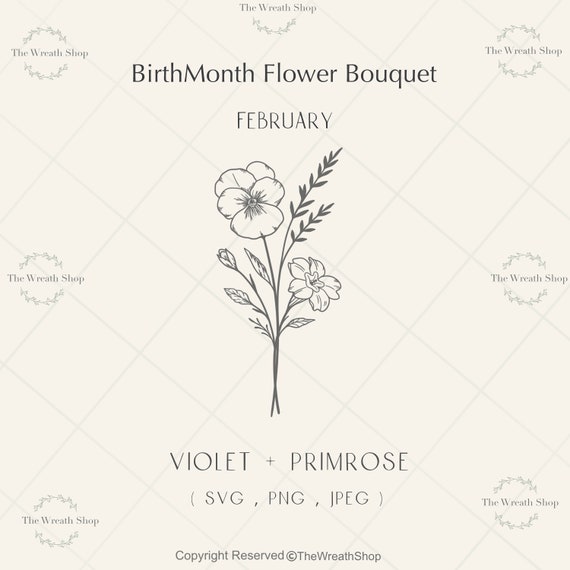
February’s Floral Favorites: Violets and Irises Delight Gardens
Violets and irises are February’s floral favorites. They symbolize faithfulness, wisdom, and hope.
Violets and irises bring vibrant colors to the cold month of February. Violets, with their delicate petals, often signify loyalty and devotion. Irises, known for their striking appearance, represent wisdom and hope. These flowers not only beautify gardens but also hold deep meanings, making them perfect for February celebrations.
Their rich symbolism and stunning hues make them a favorite choice for gifts and decorations. Embracing violets and irises in February adds a touch of elegance and sentiment to any setting. Whether in bouquets or garden beds, they uplift spirits and convey heartfelt messages.
Violets In February
February is a month known for its chilly weather and cozy vibes. It’s also a time to celebrate some beautiful flowers. One of February’s floral favorites is the violet. These small yet vibrant flowers bring a pop of color to winter landscapes. Let’s explore the characteristics and popular varieties of violets.
Characteristics
Violets are known for their heart-shaped leaves and delicate petals. They usually bloom in shades of purple, blue, and white. Some even have a sweet fragrance. These flowers prefer cool temperatures and shady spots. They are easy to grow and require minimal care. Violets can thrive both indoors and outdoors.
| Characteristic | Description |
|---|---|
| Leaf Shape | Heart-shaped |
| Petal Colors | Purple, blue, white |
| Fragrance | Sweet |
| Preferred Temperature | Cool |
| Sunlight | Shade |
Popular Varieties
There are many popular varieties of violets. Each has its unique charm. Here are a few favorites:
- Common Blue Violet: Known for its deep blue petals.
- Sweet Violet: Famous for its sweet scent.
- Dog Violet: Typically found in wild areas.
- Bird’s-foot Violet: Has beautiful, intricate petals.
- Confederate Violet: Features a mix of blue and white colors.
These varieties can be found in gardens and forests. They add beauty to any landscape. Growing violets is easy and rewarding.

Credit: www.etsy.com
Growing Violets
Violets are delightful flowers that brighten up any garden. Known for their vibrant colors and sweet fragrance, they are a favorite for February gardens. Growing violets is easy and rewarding. Follow these tips to ensure your violets thrive.
Planting Tips
- Choose the right location: Violets prefer partial shade.
- Soil preparation: Ensure the soil is well-drained and rich in organic matter.
- Spacing: Plant violets about 6 to 12 inches apart.
- Planting depth: Plant seeds 1/8 inch deep.
- Watering: Keep the soil consistently moist.
Care And Maintenance
Proper care ensures healthy, blooming violets. Follow these simple steps:
- Watering: Water regularly, but avoid waterlogging.
- Fertilizing: Use a balanced, water-soluble fertilizer every 4-6 weeks.
- Pruning: Remove dead or yellowing leaves to encourage growth.
- Pest control: Watch for aphids and spider mites. Use neem oil if needed.
- Winter care: Mulch around plants to protect roots from frost.
| Aspect | Details |
|---|---|
| Light | Partial shade |
| Soil | Well-drained, rich in organic matter |
| Water | Consistently moist, not waterlogged |
| Fertilizer | Balanced, water-soluble, every 4-6 weeks |
By following these tips, your garden will be full of vibrant violets. Happy gardening!
Irises In February
Irises are a delightful sight in February. These flowers bring vibrant colors to the late winter landscape. They symbolize hope and renewal, making them perfect for this time of year.
Unique Features
Irises stand out with their distinctive shape and vivid colors. Their petals form intricate patterns, creating a visual feast. The flowers come in a variety of hues, from deep purple to bright yellow.
One unique feature is their three upright petals, known as standards. These are complemented by three drooping petals, called falls. This structure gives irises their striking appearance.
Irises also have a special ability to thrive in different environments. Some types prefer wet conditions, while others grow well in dry soils. This adaptability makes them a versatile choice for gardens.
Common Types
| Type | Description |
|---|---|
| Bearded Iris | Known for their fuzzy stems. They come in many colors. |
| Siberian Iris | These have slender, grass-like leaves. They prefer moist soil. |
| Japanese Iris | These have large, flat blooms. They thrive in wet environments. |
| Louisiana Iris | Native to the U.S. Gulf Coast. They grow in various conditions. |
Each type of iris brings its own charm to the garden. The bearded iris is popular for its textured stems. The Siberian iris adds elegance with its slender leaves. Japanese irises offer large, dramatic blooms. Louisiana irises are versatile and easy to grow.
- Bearded Iris: Best for sunny spots.
- Siberian Iris: Ideal for borders and edges.
- Japanese Iris: Perfect near ponds.
- Louisiana Iris: Great for diverse conditions.

Credit: www.pinterest.com
Cultivating Irises
Irises are beautiful flowers that can brighten any garden. They come in various colors and sizes. To grow irises successfully, it’s essential to understand their needs. This section will guide you through the basics of cultivating irises.
Soil And Sunlight Needs
Irises thrive in well-drained soil. The soil should have a pH between 6.0 and 7.0. You can use a soil test kit to check the pH level.
They need full sun to grow well. Aim for at least 6 hours of sunlight each day. Partial shade is acceptable, but full sun promotes more blooms.
| Requirement | Details |
|---|---|
| Soil Type | Well-drained |
| Soil pH | 6.0 – 7.0 |
| Sunlight | At least 6 hours/day |
Watering And Fertilizing
Water irises regularly, especially during dry periods. Keep the soil moist but not waterlogged. Overwatering can cause root rot.
Fertilize irises in early spring. Use a balanced fertilizer like 10-10-10. Avoid high-nitrogen fertilizers.
- Water regularly, especially in dry weather.
- Use a balanced fertilizer in early spring.
- Avoid high-nitrogen fertilizers.
Mulching helps retain moisture and control weeds. Apply mulch around the plants but keep it away from the rhizomes.
Combining Violets And Irises
February brings a special charm with Violets and Irises. These flowers add beauty and color to gardens. Both flowers have unique features that complement each other. Combining them can create a stunning visual effect.
Complementary Colors
Violets often come in shades of purple, blue, and white. Irises can be found in colors like blue, purple, yellow, and white. Together, these colors can create a harmonious garden. The purple of the Violets enhances the yellow of the Irises.
Here is a simple table to show how their colors match:
| Violet Colors | Iris Colors |
|---|---|
| Purple | Yellow |
| Blue | Purple |
| White | White |
Seasonal Garden Planning
Violets and Irises bloom in different seasons. Violets usually bloom in early spring. Irises bloom in late spring to early summer. Planning your garden can ensure a continuous bloom.
Here are some tips for garden planning:
- Plant Violets in shaded areas.
- Place Irises in sunny spots.
- Ensure good drainage for both plants.
- Use mulch to retain moisture.
Combining Violets and Irises can make your garden beautiful. Their colors and blooming times complement each other well. Happy gardening!

Credit: www.amazon.com
Pest And Disease Management
February’s floral favorites, violets and irises, are stunning. Yet, they face pests and diseases. Proper management ensures their health and beauty.
Common Issues
Violets and irises often face several pests and diseases. Common problems include:
- Aphids: Tiny insects that suck plant sap, causing yellowing leaves.
- Spider mites: Small pests that create webs and yellow spots on leaves.
- Powdery mildew: A fungal disease that causes white powdery spots on leaves.
- Root rot: Caused by overwatering, leading to decayed roots and wilting plants.
Preventive Measures
Prevention is key to keeping violets and irises healthy. Follow these steps:
- Inspect plants regularly: Check for signs of pests and diseases weekly.
- Water properly: Avoid overwatering. Ensure soil drains well.
- Use organic pesticides: Neem oil or insecticidal soap can help control pests.
- Provide good air circulation: Avoid overcrowding plants to reduce humidity.
- Remove affected parts: Trim and dispose of diseased leaves or stems.
Common Issues
| Issue | Symptoms | Solution |
|---|---|---|
| Aphids | Yellowing leaves | Spray with insecticidal soap |
| Spider mites | Webs and yellow spots | Increase humidity and use miticides |
| Powdery mildew | White powdery spots | Apply fungicide and improve air flow |
| Root rot | Decayed roots and wilting | Improve drainage and avoid overwatering |
Frequently Asked Questions
What Are The Meanings Of Violets?
Violets symbolize modesty, faithfulness, and everlasting love. They are often associated with humility and spiritual wisdom.
When Do Irises Typically Bloom?
Irises usually bloom in late spring to early summer. They are known for their vibrant colors and unique petal shapes.
How Do You Care For Violets?
To care for violets, provide them with well-drained soil and moderate sunlight. Water them regularly but avoid overwatering.
What Colors Do Irises Come In?
Irises come in a wide range of colors, including purple, blue, yellow, and white. They are known for their striking beauty.
Conclusion
Violets and irises add vibrant colors to February gardens. These blooms brighten winter days and symbolize hope. Their easy care makes them perfect for any gardener. Enjoy these floral favorites and let them inspire your seasonal decor. Embrace the beauty of violets and irises this February.

